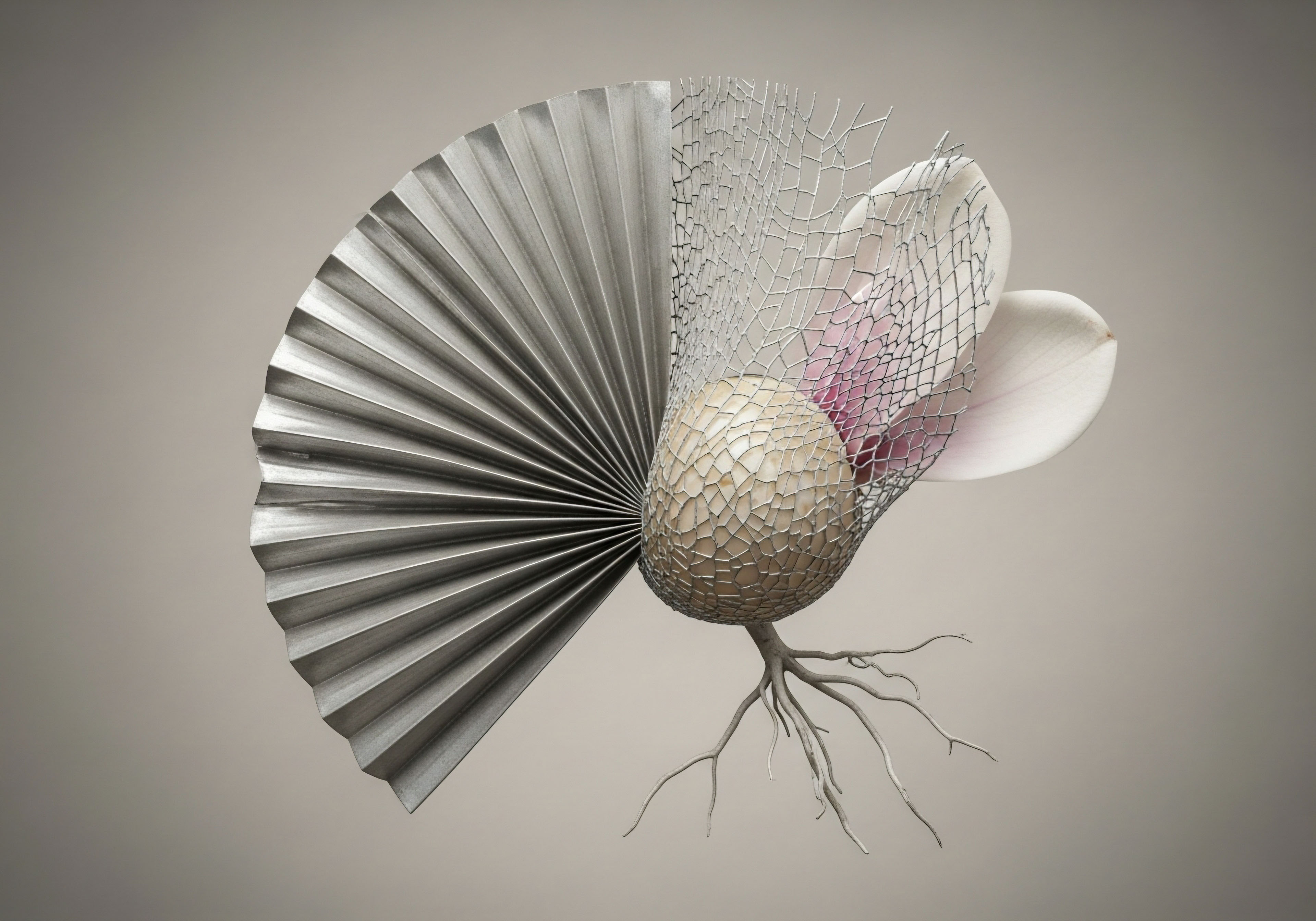

Fundamentals
The decision to begin a journey of hormonal optimization is a deeply personal one, often born from a quiet awareness that your body’s internal symphony is playing out of tune.
It might manifest as a pervasive fatigue that sleep does not seem to touch, a subtle shift in your mental acuity, or the frustrating realization that your body no longer responds to diet and exercise the way it once did. These experiences are valid.
They are the sensible signals your biological systems use to communicate a change in internal status. When considering protocols like hormone replacement therapy (HRT), a common and important question arises regarding cardiovascular health. You may have heard discussions about potential risks, and it is logical to ask how your own actions can influence that equation. The relationship between hormone therapy and the cardiovascular system is nuanced, and your lifestyle is a powerful variable in this dynamic interplay.
Understanding this connection begins with appreciating the roles that key hormones, such as estrogen and testosterone, naturally play within your circulatory system. These molecules are far more than just reproductive messengers; they are integral regulators of vascular function. Estrogen, for instance, helps maintain the flexibility of blood vessels and supports healthy cholesterol profiles.
Testosterone contributes to lean muscle mass, which is metabolically active tissue that aids in blood sugar regulation, a cornerstone of cardiovascular wellness. When these hormone levels decline with age, the protective effects they confer can diminish, contributing to an increased baseline risk for cardiovascular events long before any therapeutic intervention is considered. Therefore, the conversation about hormone therapy is one of restoring a physiological balance that your body was designed to have.
A healthy lifestyle acts as a foundational support system, preparing the body to receive and utilize hormone therapy effectively while mitigating potential cardiovascular stressors.

What Is Cardiovascular Risk
When we speak of cardiovascular risk, we are describing the probability of events related to the heart and blood vessels. This concept can be broken down into tangible biological markers. It includes the health of your endothelium, the single-cell-thick lining of your blood vessels that is responsible for regulating blood flow and preventing unwanted clotting.
Risk also encompasses the level of lipids, or fats, in your blood, such as Low-Density Lipoprotein (LDL) and High-Density Lipoprotein (HDL), and triglycerides. Another component is blood pressure, the force exerted against your artery walls. Chronic inflammation is also a significant factor, a low-grade, persistent state of immune activation that can damage vascular tissues over time.
Each of these elements is profoundly influenced by both your hormonal state and your daily lifestyle choices. A lifestyle rich in specific nutrients and regular physical activity directly supports endothelial health, promotes a balanced lipid profile, helps regulate blood pressure, and lowers systemic inflammation.

The Endocrine System Your Body’s Internal Network
Your endocrine system is the body’s sophisticated messaging service, using hormones to send signals from glands to organs. Think of it as a complex network of thermostats and feedback loops, constantly adjusting to maintain a state of equilibrium known as homeostasis.
The Hypothalamic-Pituitary-Gonadal (HPG) axis, for example, is the command line that regulates the production of testosterone in men and estrogen in women. Lifestyle factors are potent modulators of this entire system. Chronic stress, poor sleep, and a nutrient-deficient diet can disrupt these sensitive feedback loops, leading to suboptimal hormone production and function.
Conversely, a lifestyle that incorporates stress management, restorative sleep, and nutrient-dense foods creates an environment where your endocrine system can function optimally. This primes your body to respond more favorably to therapeutic interventions like HRT, as you are not asking the therapy to compensate for lifestyle-induced deficits. Instead, the therapy becomes a tool to restore youthful levels within a system that is already well-supported.
This foundational understanding is empowering. It reframes the question from a position of fear to one of proactive engagement. Your choices regarding nutrition, exercise, and stress management are not separate from your hormonal health; they are inextricably linked. By optimizing your lifestyle, you are tuning your body’s instrument, allowing the introduction of hormone therapy to create a clearer, more resonant harmony, directly contributing to the reduction of known cardiovascular risks.


Intermediate
Advancing from a foundational understanding, we can now examine the specific mechanisms through which a structured lifestyle protocol can actively mitigate the cardiovascular variables associated with hormone therapy. The interaction between therapeutic hormones and your biology is not a one-way street.
Your body’s internal environment, shaped by your daily habits, dictates how these therapies are metabolized and utilized. This section details the clinical protocols for hormone optimization and dissects the physiological impact of targeted lifestyle interventions, explaining how they work in concert to support cardiovascular resilience.

Clinical Protocols a Closer Look
Hormone optimization protocols are tailored to an individual’s specific biochemistry and life stage. The goal is to restore hormonal parameters to a range associated with vitality and optimal function, which requires precision and careful monitoring.

Testosterone Replacement Therapy (TRT) for Men
For men experiencing the symptoms of andropause, a standard protocol often involves weekly intramuscular injections of Testosterone Cypionate. This is frequently paired with Gonadorelin, which helps maintain the body’s own testosterone production signals, and an aromatase inhibitor like Anastrozole to manage the conversion of testosterone to estrogen.
The concern from a cardiovascular standpoint has historically revolved around testosterone’s potential effects on red blood cell count and lipid profiles. While some older studies raised concerns, more recent and robust research, such as the TRAVERSE trial, has been reassuring, indicating that TRT in hypogonadal men does not increase the overall risk of major adverse cardiovascular events. However, it did note a higher incidence of atrial fibrillation and pulmonary embolism, underscoring the importance of a comprehensive approach to risk mitigation.

Hormone Therapy for Women
For women in perimenopause or post-menopause, therapy is aimed at alleviating symptoms like hot flashes, mood changes, and sleep disruption, which are themselves linked to cardiovascular strain. Protocols may include bioidentical estrogen and progesterone. Some women also benefit from low-dose testosterone therapy to address energy and libido.
The “timing hypothesis” is a key concept here; research suggests that initiating hormone therapy early in the menopausal transition (typically before age 60 or within 10 years of the final menstrual period) is associated with more favorable cardiovascular outcomes. Observational studies have shown that estrogen-only therapy may even have a protective effect on myocardial infarction risk when initiated at the right time.
A well-designed lifestyle strategy does not just complement hormone therapy; it creates a physiological buffer that enhances its benefits and minimizes potential risks.

Lifestyle Interventions the Synergistic Mechanisms
A healthy lifestyle is the most potent tool available for sculpting your internal environment. Each pillar ∞ nutrition, exercise, and stress management ∞ has direct, measurable effects on cardiovascular markers that are relevant to hormone therapy.

Nutritional Architecture and the Estrobolome
Your diet is a daily instruction set for your cells. A Mediterranean-style eating pattern, rich in monounsaturated fats from olive oil, omega-3 fatty acids from fish, and polyphenols from colorful plants, directly counters inflammation and oxidative stress. These are two key pathways through which cardiovascular risk can develop.
Furthermore, the gut microbiome plays a crucial role in hormone metabolism through a collection of bacteria known as the “estrobolome.” These microbes produce an enzyme called β-glucuronidase, which deconjugates estrogens, allowing them to be reabsorbed into circulation. A diet high in fiber from vegetables, legumes, and whole grains nourishes a diverse gut microbiome, promoting a healthy estrobolome.
This ensures that both your natural and supplemented estrogens are metabolized efficiently, which can contribute to more stable and beneficial hormonal effects. Dysbiosis, or an imbalanced gut microbiome, can lead to reduced circulating estrogen, potentially impacting everything from metabolic health to cardiovascular function.
Here is a breakdown of key nutritional components:
- Omega-3 Fatty Acids ∞ Found in fatty fish like salmon and sardines, these fats are incorporated into cell membranes, making them more fluid and improving cell signaling. They also resolve inflammation.
- Polyphenols ∞ Compounds in berries, dark chocolate, and green tea that act as powerful antioxidants, protecting the endothelial lining of your arteries from damage.
- Fiber ∞ Soluble fiber, in particular, binds to cholesterol in the gut, preventing its absorption and helping to lower LDL levels. It also feeds beneficial gut bacteria.

The Physiology of Exercise
Physical activity is a non-negotiable component of cardiovascular health, working through multiple complementary pathways. Different types of exercise provide distinct benefits.
The table below compares the primary cardiovascular benefits of aerobic and resistance training:
| Exercise Type | Primary Mechanism | Cardiovascular Outcome |
|---|---|---|
| Aerobic Exercise (e.g. brisk walking, cycling) | Increases nitric oxide production, improves endothelial function. | Lowers resting blood pressure, improves blood vessel elasticity. |
| Resistance Training (e.g. weightlifting) | Increases muscle mass, improves insulin sensitivity. | Enhances glucose disposal, reduces visceral fat, improves lipid profile. |
For individuals on testosterone therapy, resistance training is particularly synergistic. It enhances the muscle-building effects of testosterone, leading to improved body composition and metabolic rate. This provides a powerful defense against the accumulation of visceral fat, a major driver of insulin resistance and cardiovascular disease. Studies have shown that walking at least one hour per week can significantly reduce the risk of coronary heart disease.

Sleep, Stress, and the HPA Axis
The Hypothalamic-Pituitary-Adrenal (HPA) axis is your central stress response system. Chronic activation from poor sleep or psychological stress leads to elevated cortisol levels. Sustained high cortisol promotes insulin resistance, increases blood pressure, and can degrade the integrity of blood vessels.
Hormone therapy can help improve sleep quality and mood, which in turn can help regulate the HPA axis. However, this effect is amplified when combined with intentional stress management practices like meditation, deep breathing, or spending time in nature. These practices help downregulate the sympathetic “fight-or-flight” nervous system and promote a parasympathetic “rest-and-digest” state, directly lowering cardiovascular strain. A lifestyle that prioritizes 7-9 hours of quality sleep per night provides the foundation for hormonal and cardiovascular stability.
By integrating these lifestyle pillars, you are creating a biological system that is resilient, balanced, and optimized. This proactive stance ensures that hormone therapy can perform its intended function of restoration without having to fight against an environment of inflammation, insulin resistance, and chronic stress. It is a partnership between modern medicine and personal responsibility.


Academic
An academic exploration of the synergy between lifestyle and hormone therapy requires a deep dive into the molecular pathways that govern vascular health. The central thesis is that lifestyle interventions, particularly those influencing the gut microbiome and cellular inflammatory responses, can fundamentally alter the risk-benefit calculus of hormonal therapies.
This occurs by modulating the very biological systems that hormones act upon. We will focus on the intricate relationship between estrogen metabolism, the gut microbiome, and the nuclear factor-kappa B (NF-κB) inflammatory signaling pathway, as these represent a nexus where diet, hormones, and cardiovascular pathophysiology converge.

The Estrogen-Gut Microbiome Axis a Critical Regulator
The bioavailability and activity of estrogens, both endogenous and exogenous, are significantly modulated by the gastrointestinal microbiota. Estrogens are conjugated in the liver (bound to other molecules) to be excreted. However, certain species of gut bacteria produce the enzyme β-glucuronidase, which can deconjugate these estrogens in the gut. This “unbinding” allows them to be reabsorbed back into circulation via the enterohepatic circulation. The collective of gut microbes with the genetic capacity to metabolize estrogens is termed the “estrobolome.”
A diet rich in fermentable fibers and polyphenols, characteristic of a Mediterranean eating pattern, promotes a diverse and healthy gut microbiome. This fosters a robust estrobolome, ensuring efficient estrogen recycling. Conversely, a diet high in processed foods and low in fiber can lead to gut dysbiosis, characterized by lower microbial diversity.
This state impairs the deconjugation process, leading to lower levels of circulating active estrogens. For a woman on a stable dose of hormone therapy, a dysbiotic gut could mean that a smaller fraction of her therapeutic estrogen is biologically available, potentially diminishing its benefits. This bidirectional relationship means that lifestyle choices directly influence the pharmacokinetics of hormone therapy.

Vascular Inflammation the Role of NF-κB Signaling
At the cellular level, one of the primary mechanisms through which estrogen confers vascular protection is by inhibiting inflammatory pathways. A key pathway in vascular inflammation is mediated by the transcription factor Nuclear Factor-kappa B (NF-κB). In its inactive state, NF-κB is held in the cytoplasm by an inhibitory protein called IκBα.
Pro-inflammatory stimuli, such as certain cytokines or oxidative stress, trigger the degradation of IκBα, allowing NF-κB to translocate to the nucleus. Once in the nucleus, it initiates the transcription of dozens of genes involved in inflammation, including those for cell adhesion molecules that cause immune cells to stick to the artery wall, a critical early step in the formation of atherosclerotic plaques.
Estrogen, acting through its receptors (ERα and ERβ), can powerfully inhibit this process. Mechanistic studies show that estrogen can suppress NF-κB activation through several means ∞ it can increase the expression of the inhibitor IκBα, block the degradation of IκBα, and directly interfere with the ability of NF-κB to bind to DNA.
This multi-pronged inhibition of a central inflammatory pathway is a cornerstone of estrogen’s vasoprotective effects. This protection, however, appears to be most effective in a low-inflammation environment and can be diminished in the presence of pre-existing vascular disease or advanced age.
The interaction between dietary polyphenols, gut microbial metabolites, and hormonal signaling pathways can create a powerful anti-inflammatory milieu that enhances cardiovascular resilience during hormone therapy.

How Lifestyle Modulates the Hormone-Inflammation Interface
This is where lifestyle interventions become critically important. The same dietary components that support a healthy gut microbiome also exert direct anti-inflammatory effects that complement those of estrogen.
- Polyphenols and Curcuminoids ∞ Compounds like resveratrol from grapes and curcumin from turmeric are known to directly inhibit NF-κB activation. They work through different but complementary mechanisms to estrogen, creating a multi-targeted suppression of this inflammatory pathway.
- Omega-3 Fatty Acids ∞ EPA and DHA are metabolized into specialized pro-resolving mediators (SPMs), such as resolvins and protectins. These molecules actively shut down the inflammatory process, a distinct mechanism from simply blocking its initiation.
- Exercise-Induced Myokines ∞ During physical activity, muscles release anti-inflammatory signaling molecules called myokines. For example, interleukin-6 (IL-6) released from muscle during exercise has anti-inflammatory properties, in contrast to the pro-inflammatory IL-6 released from adipose tissue. This helps to lower the body’s overall inflammatory tone.
The following table outlines the converging pathways through which estrogen and specific lifestyle factors impact vascular health:
| Factor | Molecular Target/Pathway | Physiological Effect |
|---|---|---|
| Estrogen (via HRT) | Inhibition of NF-κB activation; increased nitric oxide synthase (eNOS) expression. | Reduced vascular inflammation; improved vasodilation. |
| Dietary Polyphenols | Direct inhibition of NF-κB; activation of Nrf2 antioxidant pathways. | Reduced inflammation and oxidative stress. |
| Omega-3 Fatty Acids | Production of resolvins and protectins. | Active resolution of inflammation. |
| Resistance Exercise | Improved insulin signaling (Akt/mTOR pathway); release of anti-inflammatory myokines. | Reduced insulin resistance; lower systemic inflammation. |
| High-Fiber Diet | Increased production of Short-Chain Fatty Acids (SCFAs) by gut microbiota. | Enhanced gut barrier integrity; systemic anti-inflammatory effects. |
What Does This Mean For Hormone Therapy Safety?
This systems-biology perspective demonstrates that a healthy lifestyle creates a biological context of low inflammation and metabolic efficiency. Within this context, the vasoprotective actions of hormone therapy are likely to be maximized, while potential pro-thrombotic or other adverse effects are minimized.
For example, the Women’s Health Initiative (WHI), a large trial that initially raised concerns about HRT, involved an older population of women who were, on average, more than a decade past menopause and likely had a higher burden of subclinical atherosclerosis.
Initiating hormones in a pro-inflammatory environment may have different effects than initiating them in an anti-inflammatory one. A lifestyle that actively suppresses NF-κB, reduces oxidative stress, and promotes a healthy gut microbiome may effectively create the low-risk internal environment characteristic of younger, healthier individuals, thereby aligning the physiology of an older individual on HRT more closely with the conditions under which hormones are most beneficial.

References
- Baker, L. et al. “Estrogen-gut microbiome axis ∞ Physiological and clinical implications.” Maturitas, vol. 103, 2017, pp. 45-53.
- Risni, Hindun Wilda, et al. “Cardiovascular risk of hormone replacement therapy in menopausal women with diabetes ∞ a systematic review and meta-analysis of clinical trials and observational studies.” Expert Opinion on Pharmacotherapy, vol. 25, no. 15, 2024, pp. 2089-2105.
- Lincoff, A. Michael, et al. “Cardiovascular Safety of Testosterone-Replacement Therapy.” New England Journal of Medicine, 2023.
- Tang, WH Wilson, et al. “The role of the gut microbiota in health and cardiovascular diseases.” Journal of Translational Medicine, vol. 22, no. 1, 2024, p. 232.
- Stevenson, John C. et al. “Risk factors for cardiovascular disease and hormone therapy in women.” Postgraduate Medical Journal, vol. 80, no. 941, 2004, pp. 132-139.
- Miller, Virginia M. and Shane C. Loretz. “Mechanisms of estrogenic vascular protection.” American Journal of Physiology-Heart and Circulatory Physiology, vol. 291, no. 1, 2006, pp. H1-H3.
- Arnal, Jean-François, et al. “Estrogen and Cardiovascular System.” Physiological Reviews, vol. 97, no. 1, 2017, pp. 1-67.
- Knowlton, Anne A. and Anh-Dung Le. “Estrogen and Mechanisms of Vascular Protection.” Frontiers in Bioscience, vol. 15, no. 1, 2010, p. 956.
- He, Shuang, et al. “Protective Effects of Estrogen on Cardiovascular Disease Mediated by Oxidative Stress.” Oxidative Medicine and Cellular Longevity, vol. 2022, 2022.
- Basaria, Shehzad, et al. “Adverse Events Associated with Testosterone Administration.” New England Journal of Medicine, vol. 363, no. 2, 2010, pp. 109-122.

Reflection

Charting Your Own Biological Course
The information presented here offers a map of the intricate biological landscape where your hormones, your heart, and your habits intersect. This knowledge is a powerful tool, transforming abstract risks into tangible, modifiable pathways. You have seen how the architecture of your diet can influence the very bacteria that metabolize your hormones and how a simple walk can send anti-inflammatory signals throughout your body. This is the science of self-regulation and personal agency.
The path forward is one of informed partnership with your own physiology. The data and mechanisms provide the ‘what’ and the ‘how,’ but you are the expert on the ‘who’ ∞ your own lived experience, your body’s unique signals, and your personal health aspirations.
Consider this knowledge not as a set of rigid rules, but as a compass. It points toward a direction of resilience, vitality, and proactive wellness. The next step in your journey is to synthesize this understanding into a personalized strategy, a protocol built for a body and a life that is uniquely yours. This process of translation, from clinical science to personal action, is where true health optimization begins.



